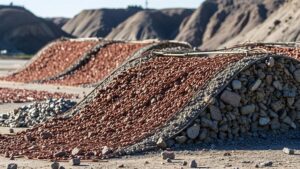The Role of Ore Hearths in Agricola’s Methods for Metal Refining
The Role of Ore Hearths in Agricola’s Methods for Metal Refining
Georgius Agricola, a prominent figure in the 16th century and regarded as the father of mineralogy, made significant contributions to mining and metallurgy through his seminal work, De Re Metallica. Among the multitude of techniques and technologies described within this text, ore hearths played a crucial role in the metal refining processes of the time. This article explores the function of ore hearths in Agricola’s methods, the technology behind them, and their lasting impact on the field of metallurgy.
Understanding Ore Hearths
Ore hearths, or smelting furnaces, were pivotal in the extraction and refinement of metals from their ores. e structures were typically made of clay or brick, capable of enduring high temperatures necessary for smelting. Agricola emphasized the importance of these devices in transforming raw ore into usable metals through the application of heat and chemical reduction.
Construction and Operation of Ore Hearths
The construction of ore hearths involved a significant understanding of materials that could withstand intense heat. Most ore hearths measured roughly 1.5 to 2 meters in height and were designed to facilitate airflow to enhance combustion. Agricola noted several key components:
- The hearth body: The main chamber where the ore was heated.
- The chimney: A structure that would allow smoke and gases to escape, maintaining a controlled environment for optimal temperatures.
- The blast pipe: An integral feature that introduced air into the hearth to fuel the fire.
By utilizing various types of wood and coal as fuel, ore hearths could reach temperatures exceeding 1000 degrees Celsius, which was essential for efficiently separating metal from its ore.
Agricola’s Techniques in Metal Refining
Agricola employed several methods in conjunction with ore hearths to refine metals, including:
- Smelting: The primary technique where metal ores were heated to extract metal, often yielding silver, lead, and copper.
- Roasting: A preliminary step to increase metal extraction efficiency by removing sulfur and moisture from ore.
- Reduction: The process of chemically reducing metal oxides back to metal, often utilizing charcoal or other reducing agents.
These methods highlighted Agricola’s understanding of both chemistry and engineering, serving as foundational practices for subsequent metallurgical advancements.
Case Studies and Real-World Applications
The practical applications of ore hearths in Agricola’s time were seen in various regions known for mining. For example, the silver mines in Saxony efficiently employed ore hearths to refine argentiferous lead ores. Historical accounts indicate that such operations could produce up to 15 tons of silver per year, showcasing the economic significance attributed to ore hearths in enhancing metal production.
Long-Term Impacts of Ore Hearths
The techniques developed through the use of ore hearths by Agricola laid the groundwork for modern metallurgy and mining practices. Today, while technology has advanced significantly with the introduction of electric and rotary furnaces, the principles of heat and air control remain constant. The understanding of metal extraction refined through the use of ore hearths has evolved but stays rooted in Agricola’s methodologies.
Conclusion and Actionable Takeaways
Agricola’s work on ore hearths established a critical juncture in the evolution of metal refining. From the construction of furnaces to the technical methodologies of smelting and refining, these techniques transformed metallurgy into a systematic process essential for industrial advancement. For those interested in the fields of metallurgy and engineering, studying Agricola’s methods can provide valuable insights into the foundations of modern practices. Investing time in understanding historical contexts can guide contemporary innovations in metal production and processing.
